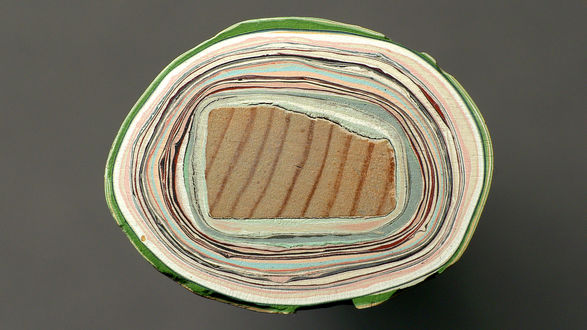My personal best in show award went to John Smith for Dad's Stick 1950-2007. This was a paint stirrer, probably made from a piece of wooden beading that his father had used to stir paint when decorating. Just prior to his father's death, his Dad had cut across the end of the stick to show the concentric rings of paint - I counted about 63 colours. What a wonderful narrative of domestic labour! Absolutely fantastic.
John Smith, Dad's Stick
Jeremy Deller had contributed John Lennon's Detention Sheet. The script said he did not know whether or not it was a forgery, but it listed such misdemeanours as 'not wearing school cap', 'homework not handed in' and 'groaning at me'! It made me remember seeing my primary school punishment book where wartime children had been punished by caning. This was usually for 'running across the road'. The school was on the A12 and a new subway had been built for children to cross the road. I think there had been a serious accident which led to the subway being built, so not using it was deemed a dangerous and heinous crime!
Jeremy Deller, John Lennon's detention sheet, 1955-6
Keggie Carew had contributed a letter to her Dad (a British wartime guerrilla in France/Burma) from an American authoress, Patricia Highsmith, who wrote Stranger on a Train. It looks as if some of her Dad's wartime stories had been used as research for Highsmith's writing - the lead character was ambidextrous, sailed a dinghy, killed only when essential …. all characteristics associated with Dad! What interested me was what was found out after a parent's death, when going through their effects, and how it changed how a child saw a parent in their memories. No photo available.
Ron Arad provided a list of pawnbrokers coupons, threaded together on a string. It was for the year 1951, January-December, and was about 8 feet long. Each one was a document of someone's hard time. Many of them had GWR describing the object pawned - gold wedding ring. I find it hard to comprehend just how dire your finances would be to pawn a significant object of status at that time. My mother's only indicator of status was her wedding ring, and being married was extremely important to her. Even though my parents hated each other, she would never have given up her wedding ring.
Ron Arad, 1951, 1973.
And looking at what appealed to me in the exhibition, I can see the same issues keep arising - domestic and mundane narrative, insignificant objects, personal memory triggered by someone else's object, script/writing/words, status.



No comments:
Post a Comment